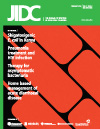Prevalence of enteropathogens in normal feces from healthy children at an infant day care in Brazil
DOI:
https://doi.org/10.3855/jidc.1982Keywords:
enteropathogen, children, day-care center, Escherichia coli, rotavirusAbstract
Introduction: The diarrhea associated with gastroenteritis is a major cause of morbidity and mortality worldwide, affecting mainly infants. The characterization of both viral and bacterial agents associated with gastroenteritis can establish policies for surveillance, prevention and treatment of infections. Group A rotaviruses are the major infectious agent associated with dehydration in children, followed by pathotypes of Escherichia coli. There are three main types of clinical infections caused by E. coli strains that have acquired virulence genes: (i) enteric and diarrheal diseases, (ii) urinary tract infections, and (iii) sepsis and meningitis.
Methodology: In this study, the objective was to identify the presence of rotavirus and diarrhogenic E. coli in the feces of children 4 to 14 months of age who displayed no gastroenteritis symptoms and stayed all day in a day-care center. We analyzed 188 samples using PAGE and PCR to identify rotaviruses and E. coli virulence genes, respectively.
Results: Thirty-six samples (19.1%) were positive for at least one pathotype of E. coli. Nineteen were identified to be of the EPEC group and fifteen of the EAEC group. Rotaviruses were not identified.
Conclusions: As EPEC and EAEC are potential pathogens for children less than one year of age or immunocompromised individuals, our results show the importance of appropriate monitoring by public health agencies. In the situation that we have studied, children can be considered asymptomatic carriers of these pathogens and can transmit them to other susceptible children.
Downloads
Published
How to Cite
Issue
Section
License
Authors who publish with this journal agree to the following terms:
- Authors retain copyright and grant the journal right of first publication with the work simultaneously licensed under a Creative Commons Attribution License that allows others to share the work with an acknowledgement of the work's authorship and initial publication in this journal.
- Authors are able to enter into separate, additional contractual arrangements for the non-exclusive distribution of the journal's published version of the work (e.g., post it to an institutional repository or publish it in a book), with an acknowledgement of its initial publication in this journal.
- Authors are permitted and encouraged to post their work online (e.g., in institutional repositories or on their website) prior to and during the submission process, as it can lead to productive exchanges, as well as earlier and greater citation of published work (See The Effect of Open Access).








